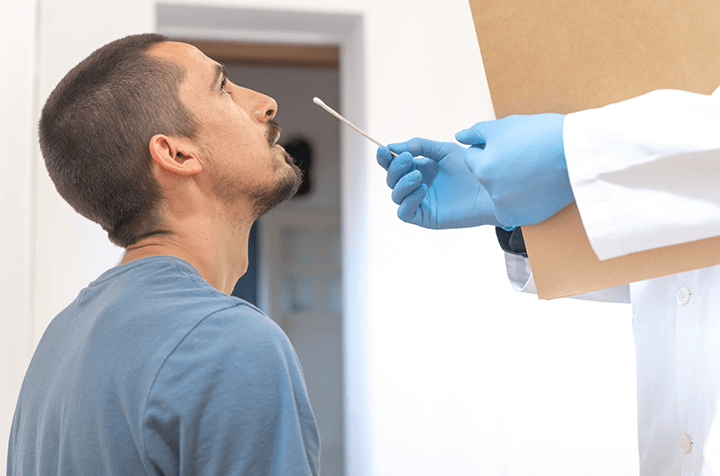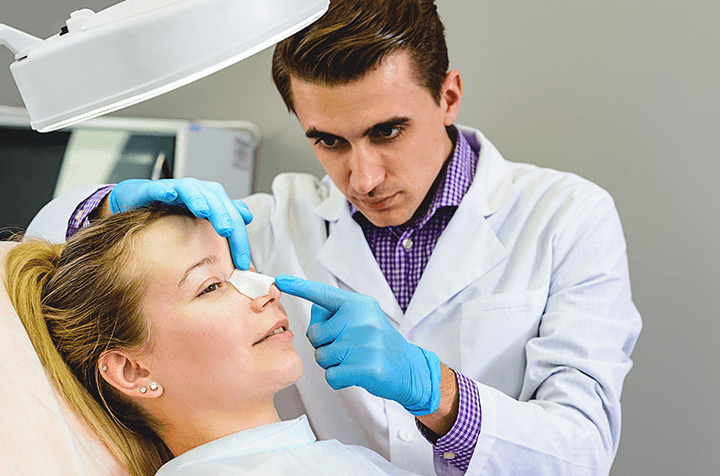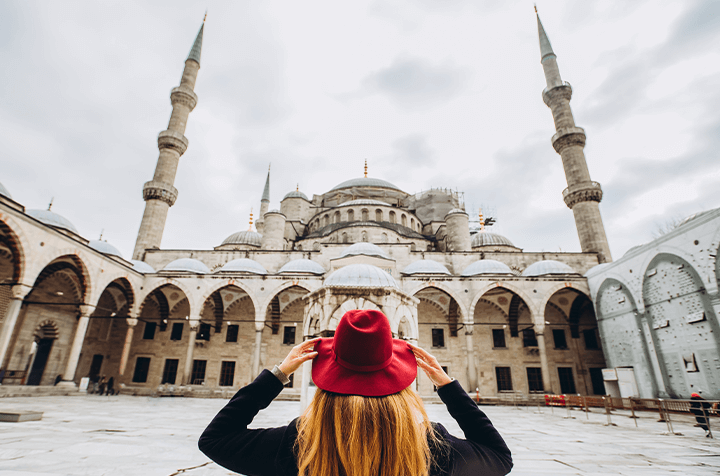Breast reconstruction is a surgical procedure performed to restore breasts after operations such as mastectomy and lumpectomy following breast cancer. Congenital deformities can also be restored.
Book your consultation
If you have lost part or all of your breast tissue due to a mastectomy, congenital deformities or other causes, you may consider breast reconstruction to address this problem.
Flap or implant-based reconstruction or a combination of the two can be used to recreate your missing breast or breasts to near normal appearance, size and shape.
Breast reconstruction is a customized and individualized procedure in that there is no standard treatment plan. It is tailored according to the needs and goals of each patient.
In general, breast reconstruction procedure involves two different methods. Flap reconstruction and implant-based reconstruction. The first one is uses your own tissue, and the
second one uses breast implants to form new breasts. Breast reconstruction can be performed at the time of mastectomy, or it can be delayed.
Breast reconstruction is a complex procedure shaped according to each patient’s needs. There are different approaches to solve different problems.

Yes, there are other options. In some cases, cancer treatments such as radiation or mastectomy leave...

If you don’t have enough tissue in the lower abdomen for abdominal-based flaps, you may consider thigh-based...

Yes, it is possible. It is called gluteal-based flaps and it might be a good option for patients who have small...

In this case, you may consider implant-based reconstruction. After cancer treatments, if you have...
Experience speaks for itself! Hear out what our patients have said:
At Clineca, we take everything seriously. We understand how important the results are for you. We care about your health and comfort as much as you do. From beginning to end, we inform you, guide you, serve you, and help you.

Surgeries are performed in prestigious fully equipped hospitals in which doctors from all specialties are present.

You will have an online consultation with your surgeon via video chat. After an online examination, and will help you to choose what's the best.

We cooperate with the surgeons who perform a limited number of surgeries each week to ensure the best results.

You can contact our agents 7 days and 24 hours for your questions and concerns, or only support. We'll be fully available for your service.

We provide you with special discounts in luxurious hotels in the vicinity of the hospital. Your comfort is very important to us.

We provide airport transfer and transportation between your hotel and the hospital before/after the surgery via VIP vehicles.

As Clineca, we provide you with patient accompaniment, who will visit you every day in your hotel room during the resting period.

The price includes fees of the surgeon, operating room, hospitalization, tests, medications and medical visits by a nurse.

The price includes hotel layover (including breakfast), and transportation between the airport, the hotel and the hospital.

Interpreter service, BBL pillow, neck pillow (rhinoplasty), eye mask, voltage converter and many others that will enhance your satisfaction.

Turkey is a leading player in medical tourism, and Istanbul, which is an extremely beautiful touristic city, is the plastic surgery capital of Turkey.
Clineca has a holistic approach. We believe that everything should be right for a satisfactory cosmetic surgery experience, including your days in Istanbul. We plan every detail of your journey.
After you fill the form, one of our agents will contact you. They will inform you about the whole experience, in detail. If requested, they will arrange an online consultation for you.
You'll have an online consultation with your surgeon via video chat. They will perform an online examination and help you to choose what the best approach to your case is.
We'll plan your whole journey including your surgery date and accommodation. We'll inform you about every need; from preparing your suitcase to advice before the procedure.
Our VIP transportation vehicle will be ready at the airport for you. We’ll drive you to the hospital and they'll get a blood and the C19 test. Then, we'll take you to your hotel.
We’ll take you from your hotel to the hospital. After your examination, the same day you’ll have the surgery. You will stay at the hospital 1-2 day(s), depending on the procedure.
After your stay at the hospital, we'll drive you to your hotel. A wellbeing assistant will visit you every day to inform you, to examine, and to provide medical care during the week.
We'll gladly and proudly show you around our beautiful city. We’ll be very happy to provide you with professional guidance in historical sightseeing, shopping and entertainment.
We’ll take you to 1-week follow-up. After your examination and removal of bandages if required, we’ll inform you about the recovery period. Then, we'll drive you to the airport.
During your recovery, we'll inform you, check on you, and answer your questions 24 hours and 7 days. We'll expect you to send photos periodically to follow your recovery period.

You may be a good candidate if you:
The outcomes of Breast Reconstruction can be analyzed in two main categories: aesthetical and psychological.
Breast reconstruction can address your aesthetical concerns about your breasts. Through breast reconstruction, your missing breast or breasts can be recreated. The size, the shape, and the proportions of your breasts can be enhanced to near normal appearance. Your breasts look better, and you may enjoy fitting into bras and bikinis. You may wear low-cut clothes that you want to wear.
The psychological outcomes of the procedure are as important as the physical ones. If you are not happy with the appearance of your breasts, it’s likely that you experience psychological distress, which can negatively affect your self-confidence and social life. After breast reconstruction procedure, you will have a more positive self-image. Your new recreated breasts will boost your self-confidence, and you will feel wholeness and femininity again.

Breast Reconstruction is a cosmetic surgery procedure performed to change the appearance of the breasts. It is customized according to needs and wishes of the patient.

Foremost, you will receive anesthesia medications. Depending on the particular case, the surgery can be performed under either general anesthesia, or local anesthesia combined with a sedative. If it is performed immediately following mastectomy, general anesthesia is typically used but if it is a delayed reconstruction, the type of anesthesia may differ depending on the complexity of the reconstruction procedure. In either case, you will not feel pain and discomfort.
Breast reconstruction is an entirely customized and tailored procedure, and different techniques can be used based on your individual needs and desired outcomes. Your new breasts can be constructed using your own tissue, or with the placement of an implant, or a combination of the two. There are generally two types of reconstructive procedures: Flap and Implant Reconstruction.*1


Flap reconstruction or tissue-based reconstruction is a more extensive procedure, but its results are generally lifelong, and it gives a more natural appearance and feeling. It matches with your existing contra-lateral breast. Tissue-based reconstruction involves performing what is known as “flap”. It requires tissue transferring (muscle, skin and fat) from other areas of your body. The most common method is to transfer tissue from the abdomen to the chest in order to recreate the breasts. The tissue transferred from the abdomen is reshaped into a breast.
Implant-based reconstruction usually consists of more than one procedure. Broadly, in the first stage, a tissue expander is placed under the chest muscle to stretch the remaining skin enough to cover the implant, and it generally takes 6 to 8 weeks to prepare the area for reconstructive surgery. In the second stage, the tissue expander is removed, and a silicone or saline breast implant is placed to reconstruct the breast. If you have enough skin to cover the breast, the implant can be directly placed. Implant-based reconstruction has a faster recovery and is simpler than tissue-based reconstruction. However, the implants cannot be permanent and would need to be replaced after 10-15 years.

Although various methods for both immediate and delayed breast reconstruction are feasible and safe, risks depend on the patient variables and the choice of procedure and these will be discussed during consultation to select the most appropriate and least-risky method. The overall complication rate was calculated to be 10.2%.
Contributor factors to complications:
Patient related factors:
Mastectomy site complications:
Flap-related complications:
Implant/expander related Complications:
Surgeon Related Factors:
After the operation, your breasts will be covered with bandages. Gauze can be applied to your incision sites. You may be asked to wear a support bra or an elastic bandage in order to minimize swelling and support your reconstructed breasts. A small tube may be placed under your skin to drain excess fluid. You may experience some numbness, tightness and discomfort that can be eased with pain medication. You should follow the post-op instructions precisely and use only the medications approved by your surgeon.
You may expect swelling, bruising and soreness to last for 2-3 weeks. Depending on the reconstruction type, it may take 4 to 6 weeks to return regular activities, and it may take months to resume strenuous exercises, and to completely heal. You should take into consideration that your newly reconstructed breasts will probably not have the exact shape and sensation as before, but in time, some feeling should return. Scarring will be minimized with the help of advanced techniques, but keep in mind that some scarring is inevitable, but the visibility of the scars will fade over time. It may take time to get used to the reconstructed breasts but, in time, you will feel that reconstructive operation dramatically enhances your overall appearance and quality of life.
A wellbeing assistant will visit you in your hotel room every day during the first week after the surgery. We will expect you to be in our clinic for your post-op examination 1 week after the surgery, before you leave Istanbul. We will still follow your recovery process while you are away. Clineca will provide you with complete support and inform you about everything you need to know during your recovery. We will be with you from your consultation to the very end of your recovery.

“Through customizable procedures and the advanced techniques, now, we have a high potential to provide a more natural feeling and appearance to your breasts. After the operation, you will feel sexy and comfortable, and your self-esteem will be improved. No one will be able to tell that you had a breast reconstruction procedure.”

During your online consultation, your surgeon will ask you questions about your medical history. It is of critical importance that you give your doctor every detail, from the conditions you might have to the operations you had in the past, to the medications and supplements you use, to minimize the risks the surgery could bring. They will also conduct a physical examination. Your surgeon will inform you about everything you need to know before the surgery. Clineca will provide you with complete guidance and support before your surgery. You will have a complete and detailed list of instructions.
Most important instructions include,


What you need to do after the surgery will be explained to you in detail by your surgeon, and Clineca will provide you with all the support and guidance you need.

“People think breast reconstruction is only for cancer patients. That is not true. Congenital conditions, missing or deformed breasts caused by physical traumas or infections can be corrected through breast reconstruction.”

We know you have many questions. Having realistic expectations and deciding to have a cosmetic surgery requires information. Here you can find answers to frequently asked questions about breast reconstruction.
Breast reconstruction is a complex procedure shaped according to each patient’s needs. There are different solutions to different problems that you can find below.
1. Kaya, B., & Serel, S. (2013). Breast reconstruction. Experimental oncology, 35(4), 280–286.
2. Brennan, D. (2021, April 12). What is a Seroma? WebMD. May 12, 2022. https://www.webmd.com/skin-problems-and-treatments/what-is-a-seroma
3. Browne, J.P., Jeevan, R., Gulliver-Clarke, C., Pereira, J., Caddy, C.M. and van der Meulen, J.H.P. (2017), The association between complications and quality of life after mastectomy and breast reconstruction for breast cancer. Cancer, 123: 3460-3467. https://doi.org/10.1002/cncr.30788
4. Gupta, V., Yeslev, M., Winocour, J., Bamba, R., Rodriguez-Feo, C., Grotting, J. C., & Higdon, K. K. (2017). Aesthetic breast surgery and concomitant procedures: Incidence and risk factors for major complications in 73,608 cases. Aesthetic Surgery Journal, 37(5), 515–527. https://doi.org/10.1093/asj/sjw238